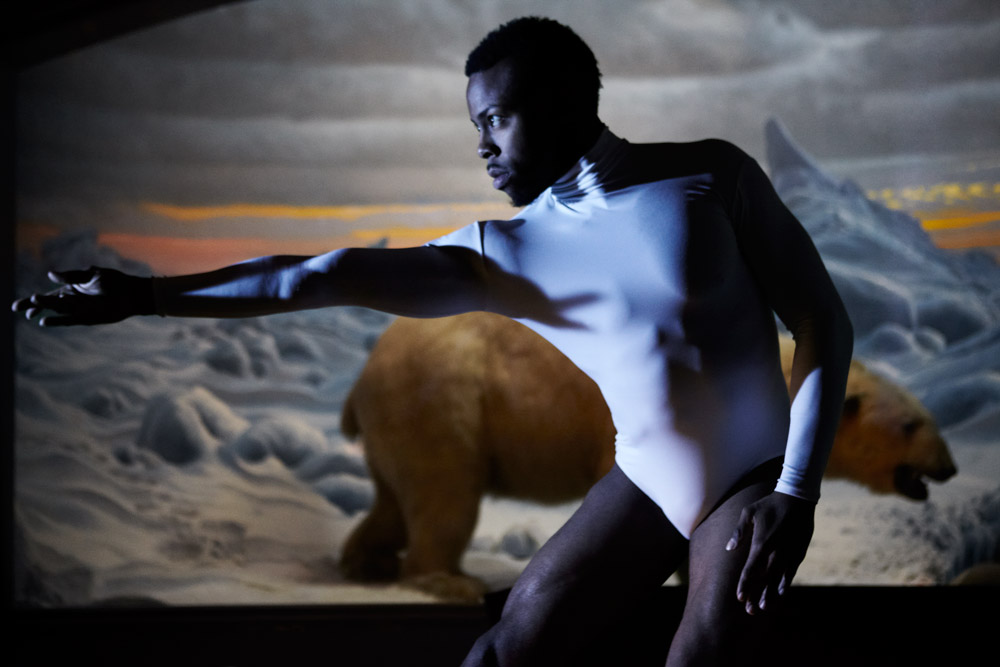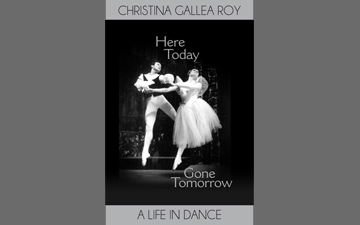
© Julieta Cervantes. (Click image for larger version)
Armitage Gone! Dance
On the Nature of Things
New York, American Museum of Natural History
25 March 2015
www.armitagegonedance.org
www.amnh.org
Karole Armitage is in a groove, and it’s environmental. On the Nature of Things, presented at the American Museum of Natural History, is her latest in a string of works addressing the all-too-rapid ecological devastation humans are wreaking on the planet.
Standing beneath a 94-foot model of a blue whale, Armitage Gone! Dance veteran Megumi Eda opened the work with elegant, sinuous movement. Her cheekbones are high, her eyes smoky and her skin more soaked than dewy. She looks like she’s been crying for hours, embracing the plaintive, defeatist look of Kate Moss’s “heroin chic.” Eda’s touch is delicate, as light as a feather, except when she taking a plunge—a sauté down rather than up—into a deep crouching frog-like pile, and slaps her thighs. This proves a recurring feature across OTNOT, which, along with body sniffing and sharp head movements, peppers the work with animalistic tics.

© Julieta Cervantes. (Click image for larger version)
Staged in the center of the Milstein Hall of Ocean Life, OTNOT is framed by chilly dioramas of elephant seals, coral, cephalopods and polar bears. Armitage chose a similarly cool range of musical accompaniment, including Philip Glass, Michael Gordon, John Luther Adams, Arvo Pärt, and Henryk Górecki, punctuated by live readings from Paul Ehrlich – a population biologist, family friend of Armitage and the inspiration for the piece.
Ehrlich is a multi-award-winning scientist whose basic premise is that overpopulation has serious, largely irreversible consequences for the planet and the human race. Ehrlich also quotes from The New Yorker’s science writer Elizabeth Kolbert, the author of The Sixth Extinction, a book whose title says it all. Ehrlich’s readings, full of factoids about the ravaging of the planet, weigh heavy on the heart when heard in a room full of endangered and near-extinct species.
But what of the dancing? Eda’s opening sequence is exquisite in its balletic restraint, but sadly things don’t carry on in this vein for long. The full force of dancers – a mix of Armitage Gone!’s eight-member troupe, artists from the New York dance community and the Manhattan Youth Ballet – are clad in long-sleeved, high-neck leotards in neon orange, the color of prison uniforms and hazmat suits. Bodies swarm on and offstage, competing for space, sex and survival. The overpopulation theme is heavy-handed but effective: there is no way an audience could misinterpret it.

© Julieta Cervantes. (Click image for larger version)
Initially Ehrlich’s words washed over me, taking a back burner to the partnering work of Eda and Cristian Laverde Konig. But towards the latter half of the piece, the choreography took a backseat to Ehrlich’s readings. Whether it’s because the quotes became more drastic, more potent, more abysmal in their outlook for both the planet and humanity or because the choreography lost its focus, it’s hard to say. If there is a detailed narrative, it is hard to follow, though there seems to be some savage cannibalism, except the dancers always return, so, perhaps the situation isn’t as dire as it seemed. There are numerous Forsythean moments, full of gymnastic extremes and tugs of war, but the images that linger longest in the mind are the swarmings, the jogging on and offstage and the hectic desperation of survival tactics that consume the piece.
Artistic partnerships are tricky. Dance is in a committed relationship with music. Add in speech, whether narrative or not, fiction or nonfiction, and it throws a wrench into the mix. It is rare the ménage à trois works on a substantial level, wherein the viewer soaks up a complete vision, absorbing all elements in a well-synchronized package. OTNOT ends with a group of small children pointing upwards to a solitary light, one of them lifted up to touch it, as if some kind of child savior. The “circle of life” ending seems trite and disingenuous when the crux of the work is informed by Ehrlich’s words which don’t look kindly on unchecked human reproduction.

© Julieta Cervantes. (Click image for larger version)
The effectiveness of OTNOT as a work of art is mixed, as are its pontificating qualities. While as an audience member I might be somewhat unusual in the respect that by age eight I was donating my $1 weekly allowance to Greenpeace and the Nature Conservancy, there is the question of how effective Armitage’s work is from a political standpoint. Forgive the broad generalization, but art and museum patrons tend to be fairly liberal, progressively-minded citizens. Whom is Armitage converting to her eco-minded awareness? The message she is trying to convey is probably best disseminated among populations of people who may never see her work.
That said, if nothing else, Armitage’s choice of venue is on point. Walking out of the Milstein Hall of Ocean Life requires walking by two large, stunning, taxidermy tigers in the Hall of Biodiversity. According to the WWF, one tiger protects 25,000 acres of forest, and the global tiger population has dropped by 97% in 100 years; the sixth extinction is no prediction, it is now. Hopefully I won’t be the only one who, post-performance, makes a donation.

















You must be logged in to post a comment.